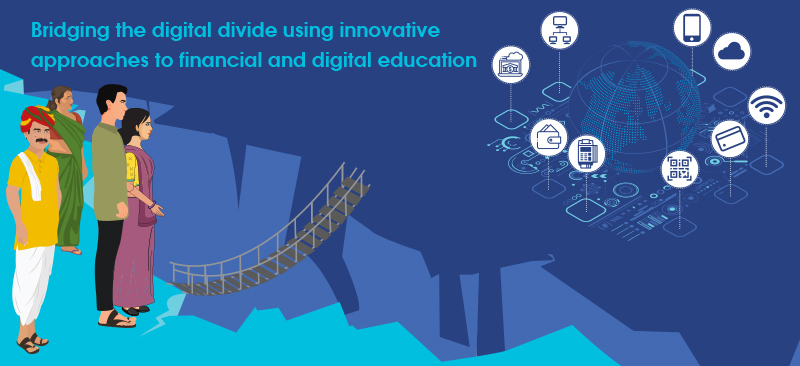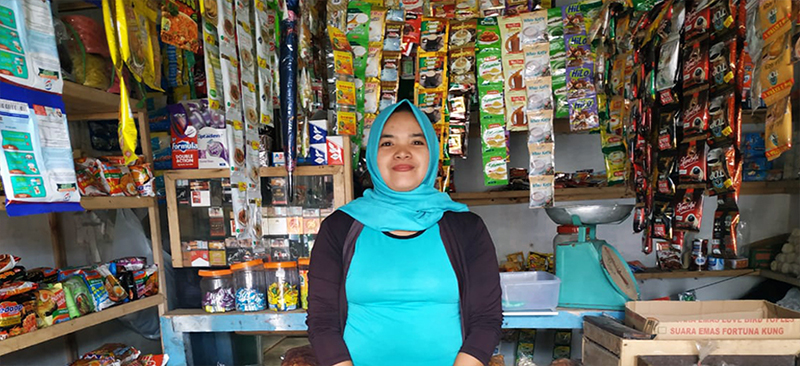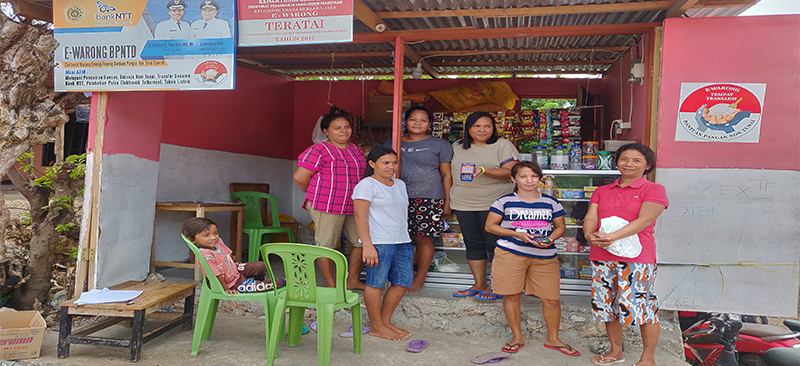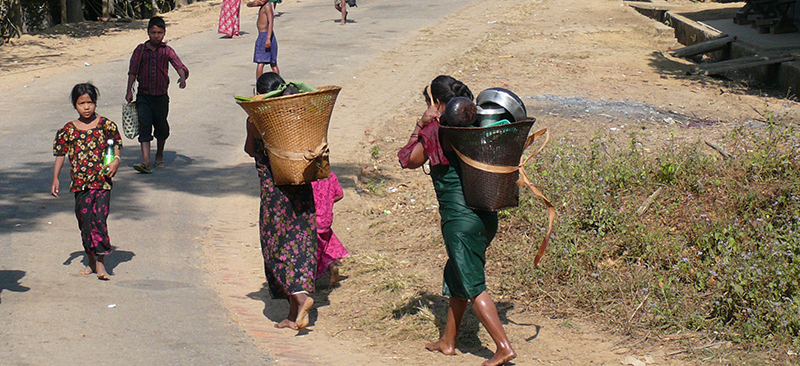[podcast_playlist series=”bridging-the-digital-divide-using-innovative-approaches-to-financial-and-digital-education”]
Blog
Life on credit: Why and how do corner shop owners take loans?
Yuyun sells food items and products of daily use from a small shop from her home in Central Java, Indonesia. By late February, 2021, Yuyun had four outstanding loans. While four concurrent loans seem excessive, Rahmat Kabir from Hrishipara in central Bangladesh goes a step further. By the middle of 2021, Rahmat had 13 outstanding loans—seven from multiple microfinance institutions (MFIs), five from friends, and one from a neighbor.
However, juggling multiple loans is not common to all micro-enterprise owners. Only two of our diarists from India had more than two outstanding loans—most had either one loan or no loan at all. One such diarist, Manish Chouhan, runs a grocery shop in Madhya Pradesh, India. Manish was trapped in a vicious cycle—reduced stocks due to a drop in income led to lower sales and a consequent decrease in revenue. To break this cycle, Manish had to borrow INR 10,000 (~USD 134.79) from his friends to purchase supplies for his shop.
These examples illustrate the difference in borrowing patterns in the three Asian countries of our Corner Shop Diaries research—India, Indonesia, and Bangladesh. By analyzing the loan transaction data of our diarists, we identified the key insights discussed below.
1. Taking loans is more common in Bangladesh, followed by India and Indonesia
Only eight out of 25 diarists had outstanding loans in India. These diarists had a total of 10 outstanding loans. In Indonesia, 10 diarists had a total of 17 outstanding loans, while in Bangladesh, four out of five diarists had as many as 27 running loans in total. Bangladesh also tops the list in terms of total loan value disbursed, as depicted in Graph 1. The reason behind the significant difference in the number and value of loans is the phenomenal growth of MFIs in Bangladesh since the 1990s. These MFIs facilitate access to credit for the low- and moderate-income (LMI) segment in rural and urban areas.
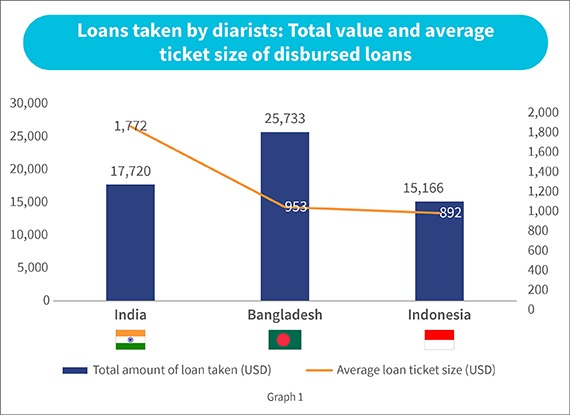
Other possible reasons for the difference in number and value of loans across countries:
The diarists did not divulge the details of loans taken willingly. We had to gain their trust and make them comfortable enough to reveal this information. Taking loans is not a desirable practice in the cultures of some of our countries of research. This may be a significant factor responsible for this reluctance in sharing information, and the levels of reluctance also vary across countries. Another factor is the difference in skills of data collectors who acquired the sensitive information related to credit. However, we can safely assume that these are not the only factors that contribute to the significant difference in the number of loans. Borrowing behaviors may also vary based on historical and market-level aspects of the country, as mentioned before.
2. Banks and MFIs are significant sources of loans
In general, borrowers in India prefer to take loans from formal institutions- mainly banks and some NBFCs. In Indonesia, informal institutions like Rotating Savings and Credit Associations (ROSCAs) and formal institutions like banks, cooperatives, and MFI are familiar sources of loans. With the historical evolution of its microfinance industry to curb rural poverty, MFIs are the major source of credit in Bangladesh . The country has been expanding its banking industry to push economic growth—most recently through agent banking. Besides these sources, borrowers in Bangladesh also take loans from informal sources like friends and family.
These practices reflect the experiences of our diarists in these countries. Diarists in India prefer to secure loans from banks, with seven out of 10 loans taken from banks. In Indonesia, diarists took almost half of the loans (eight out of 17 or 47%) from MFIs, five from banks, and the remaining four from other sources like cooperatives and friends or relatives. Since we conducted our research in the primary working area of CU Lestari, our partner in Indonesia, several diarists have outstanding loans with the MFI.
Due to the overwhelming presence of MFIs in Bangladesh, diarists took 70% i.e. 19 out of 27 loans from MFIs. The remaining eight loans were taken from informal sources like friends and relatives. The abundance of access is a major factor that influences the choice of borrowers regarding the source of the loan. Prominent MFIs like Grameen Bank and BRAC, mid-sized MFIs like DSK, and smaller local MFIs like Sahaj Sanchay operate in Hrishipara, the area that our project covered. This made it easier for diarists to take multiple loans, either under their names or through accounts owned by people they know. Moreover, most MFIs in Bangladesh have also relaxed their terms of repayment after the pandemic.
The interest rates also vary significantly depending on the source of the loan. In India, banks charge interest rates of 7% to 13%, whereas money lenders charge interest as high as 18%. In Indonesia, the interest rates range from 2% to 24%, and in Bangladesh, they can go as high as 36% per year.
Informal loans from friends or relatives are usually interest-free and have flexible terms of repayment. Hence, these loans are the first choice for many. Informal loans are also the choice of instrument to repay other outstanding loans with stricter terms of repayment.
3. Diarists take loans primarily for business purposes
Diarists in India took more than half of the loans (six out of 10) for personal reasons and the other four to support their businesses. However, loans for business or livelihood were more predominant in Indonesia and Bangladesh—11 out of 17 (65%) loans in Indonesia and 22 out of 27 (81%) loans in Bangladesh were business loans. In Bangladesh, borrowers take business loans but often use the amount for various purposes. Borrowers generally use informal loans for a single purpose, such as to on-lend to others or repay debts, or smoothen their income. They consume such loan amounts swiftly. In contrast, borrowers use MFI loans mainly for business purposes and spend this amount slowly. They also use some parts of such loans to repay other loans or smoothen their income, among others.
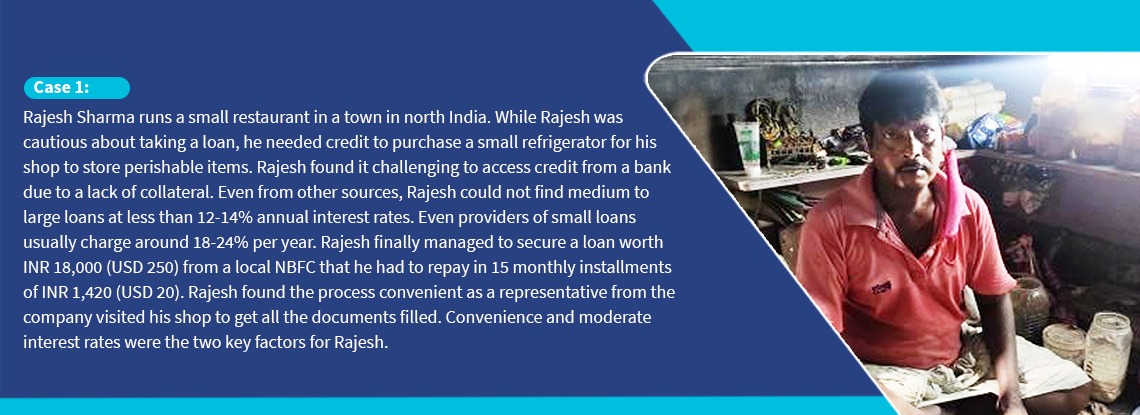
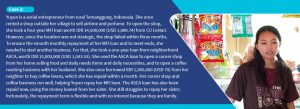
Conclusion
The samples[1] from India, Indonesia, and Bangladesh highlight the difference in behavior regarding loans in South and Southeast Asia. Financial service providers can extract essential lessons from the complete picture of how and why borrowers take loans, their pain points, and the catalysts of loan adoption.
Loans are not always a burden but a stepping stone for growth, as evident in Case 1. Micro and small enterprises need access to finance to scale up and grow their business. Even small loans can have a significant impact on these enterprises. Loans help in consumptions smoothing, to build a cash reserve or to repay another loan, as highlighted in Case 2. However, mostly informal micro-enterprises still struggle with the lack of loan products tailored to their needs.
Stakeholders can learn from the example of CU Lestari—the MFI has attracted numerous LMI customers through its direct approach, such as providing a cash pick-up service for loan repayments. As businesses bounce back after the pandemic and the demand for credit rises, early movers will reap the benefit.
[1] We have not extracted the diaries data from a representative sample. Hence, the insights cannot be generalized.
Wi-Fi voucher: A top-selling product for rural corner shops in Indonesia
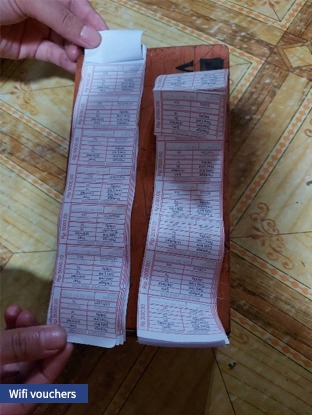 Corner shop owner Yuyun finds it difficult to connect to the internet on her phone from her village of Gunungpayung in the hilly terrain of Temanggung regency. The village in Central Java lies 458 kilometers east of the capital of Jakarta. Yuyun sells daily necessities from a corner shop in her home. She also runs a coffee roasting business in the village. She is one of our diarists from MSC and L-IFT’s Corner Shop Diaries project. Gunungpayung is not the only rural area in Indonesia that has no or limited internet access.
Corner shop owner Yuyun finds it difficult to connect to the internet on her phone from her village of Gunungpayung in the hilly terrain of Temanggung regency. The village in Central Java lies 458 kilometers east of the capital of Jakarta. Yuyun sells daily necessities from a corner shop in her home. She also runs a coffee roasting business in the village. She is one of our diarists from MSC and L-IFT’s Corner Shop Diaries project. Gunungpayung is not the only rural area in Indonesia that has no or limited internet access.
However, even though she faced difficulties accessing the internet, Yuyun used several methods to sell her products to her clients, who live as far away as Jakarta. These included the use of WhatsApp to advertise her small business, promotional posters that she created on a design app, and Shopee—an e-commerce platform—to sell her products. What is her secret of being technologically savvy and well connected in a place without internet access?Reports indicate that access to 4G networks evades 12,548 villages in the country. While 90% of 4G signals are available in urban areas, the number falls to only 76% in rural areas. In Java, the most developed and populous island in the archipelago, the internet penetration rate is only 56.4%. In less populous islands, such as Sulawesi and Papua, the rate of internet penetration falls to below 10%. This inequality results from various factors, including geographical conditions, a notion among providers that rural and sparsely populated areas are not profitable, and a lack of regulation in infrastructure and frequency-sharing.
Yuyun showed us a box stenciled “Voucher – Wi-Fi” where she kept a pile of paper coupons (the vouchers). The coupons allow buyers to access the internet. She sells two kinds of coupons, one worth IDR 2,000 (~USD 0.14) for two-hour unlimited use and another worth IDR 5,000 (~USD 0.35) for all-day unlimited use. Such coupons are reasonably cheap and cost the same as a small box of milk that children usually buy. The package details are printed on the coupon. Customers only need to turn on the Wi-Fi feature on their mobile phone, enter the username and password, and connect to the internet.
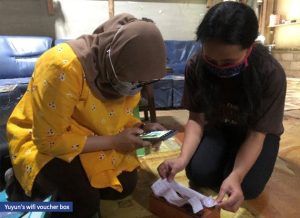
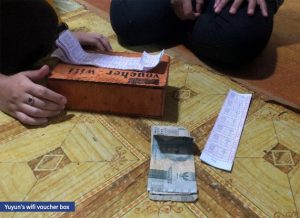
The chart below shows the share of Wi-Fi voucher sales in Yuyun’s weekly revenue compared to other products, for example, snacks and daily necessities. The revenue from Wi-Fi voucher sales varied from time to time, from IDR 8,000 (~USD 0.56) to IDR 185,000 (~USD 12.96) per week. It shows that despite not being the main selling product, the Wi-Fi voucher remained a constant part of Yuyun’s total revenue.

Yuyun is not the only one who sells Wi-Fi vouchers in her area. The Wi-Fi voucher business is mushrooming, especially in densely populated areas with many blank spots in Temanggung and Wonosobo. The business model of Wi-Fi vouchers is through agencies. Small sellers like Yuyun are agents who receive routers and coupon papers from larger entrepreneurs. These entrepreneurs usually understand networks and other technical issues better and also determine the market price of Wi-Fi vouchers. Agents like Yuyun earn around IDR 500 – IDR 1,000 (~USD 0.035 – USD 0.070) from sales per coupon.
The signal of the Wi-Fi network, which Yuyun sells vouchers for comes from an access point device installed in her house. The access point functions as a “repeater” and extends the range of the internet signals that the users could not reach earlier. Yuyun spent IDR 70,000 (~USD 4.89) to install the access point. Meanwhile, the fee charged for personal use is IDR 350,000 (~USD 24.45) for access point installation and IDR 30,000 (~USD 2.10) for internet usage per user per month.
The Wi-Fi signal is sourced from the fiber optic cables owned by big internet providers, such as PT Telekomunikasi Indonesia (IndiHome). The Wi-Fi voucher entrepreneurs usually live close to the location of the fiber optic cables. They subscribe to internet data from an established provider and then they connect their modem to the router using a LAN cable. This router serves as a bandwidth distributor. Some routers also have an implanted access point to transmit the signal to the user, although others have to buy an access point device separately. The router has hotspot software embedded. The device is then connected to the PC using a cable to operate the software. The Wi-Fi voucher entrepreneur then sells the Wi-Fi signal through agents like Yuyun. They install access point devices in the agent’s house or corner shop so the signal can be distributed there. Ideally, Wi-Fi users should be maximum of five meters from the access point device to get optimum signal strength.
The router, access point devices, and other tools needed for this business are not hard to procure. These tools can be purchased easily at local computer stores or through e-commerce platforms. The prices also vary and are dynamic following the fluctuation of the USD exchange rate.
The quality of the Wi-Fi signal is more stable than the ordinary mobile network signal because it comes from an optical cable and is relayed by several extenders constantly. Errors or outages are rare. When they occur, it is usually for three reasons. First, the big providers may experience system disruption, for example, due to extreme weather. Second, the Wi-Fi entrepreneur may not have paid the internet subscription bill to the primary provider. Third, the access point device may be damaged, for example, due to unstable electricity or lightning strikes. Disruptions are rare because the big providers carry out system maintenance routinely and the electricity supply is usually good. However, if services are disrupted, an agent like Yuyun cannot do anything because they depend heavily on the performance of the Wi-Fi entrepreneur and the primary provider.
The Wi-Fi voucher model is not something new. Big mobile providers like Telkomsel have previously sold internet voucher products at affordable prices. The demand for internet packages has increased since 2013, along with the widespread use of Android-based mobile phones. However, the bigger mobile providers’ signal usually comes from a base transceiver station (BTS) tower, which is not as stable as the signal from optical cables. Compared to optical cables, the BTS tower has a broader coverage area. The signal from the BTS tower faces more obstacles or blockaders, such as hills, large trees, and buildings, resulting in blanks spots. The Wi-Fi voucher business carried out by local entrepreneurs who use optical cables covers these gaps.
The Wi-Fi voucher customers are diverse. However, Yuyun observed that the low-priced packages are usually in demand by children and teenagers, while adults usually consume the more expensive packages. The Wi-Fi voucher is used mainly for online gaming, streaming via YouTube and Facebook, and downloading big-sized data. These vouchers have also helped support school-from-home activities, which corresponds with MSC’s study that household internet needs have spiked during the pandemic.
Coming back to Yuyun, we see that despite limited access to resources, Wi-Fi vouchers proved to be an opportunity. The entrepreneur used the internet to develop her business despite limited access to resources. However, information obtained from the internet was not the only inspiration for Yuyun to become technologically savvy. For example, migrant neighbors or relatives visiting from the city also gave Yuyun insights into current events and opportunities for those like her who lived in rural Indonesia.
Even though Yuyun is internet literate, she is yet to explore other technological tools and services. For example, she has never tried using digital payments. Her store on the e-commerce platform Shopee is dormant, and she is yet to reactivate it. Yuyun is young and relatively more tech-savvy compared to other micro-entrepreneurs in her village. However, concerted efforts from both public and private sectors are needed to enable digital infrastructure and provide digital skills to micro-enterprises in remote rural areas. These efforts can then speed up the trickle of benefits from Indonesia’s booming digital economy down to the villages like Gunungpayung.
Countries such as India and China now harness the benefits of public investments from building an inclusive digital infrastructure. Yet digital infrastructure alone is not adequate to ensure inclusive digital ecosystems: awareness, skills, and the application of digital tools are required.

Indonesia has set ambitious goals through the BAKTI program, UKM Naik Kelas, and Payments Vision 2025 to ensure that country is well prepared to build an inclusive digital economy. While such programs encourage the private sector to provide digital services to the last mile, they must also use rural community networks to ensure effective delivery and enhanced adoption of their program and initiatives. Involving and empowering rural entrepreneurs like Yuyun is crucial.
Digitizing public finance architecture is the need of the hour
Prime Minister Narendra Modi in his recent Independence Day speech spoke about how India’s development aspirations were being hit by poor public service delivery.
India’s poor public service delivery has vexed scholars and practitioners for decades. The state possesses immense ability to execute large and complex undertakings such as the national elections or the rollout of the systemic changes such as the Goods and Services Tax (GST) regime or the United Payments Interface (UPI).
Road connectivity and quality has improved greatly on account of flagship programmes such as the PM Gram Sadak Yojana. Yet, primary healthcare centres in rural or even poorer urban pockets continue to remain ill-equipped.
UNICEF states that inadequate water, sanitation and hygiene (WASH) services in the country’s health facilities contribute to the high neonatal rate of 24 per 1,000 live births with sepsis contributing to 11 per cent of maternal deaths. Government schools, woefully understaffed across the hinterland, often lack access to electricity, toilets and basic infrastructure which adversely impacts learning outcomes among children.
India has undoubtedly made enormous strides in economic prosperity. There is, however, work that remains to be done.
In this regard, a specific short-term focus for the government must be on managing its expenditures at a time of considerable fiscal pressure. The near-term challenge lies in getting the maximum bang for each welfare buck spent while enabling efficient and effective last-mile service delivery.
Public financial management (PFM) is a major fulcrum that will determine if the aspirations of all Indians can be fulfilled over the next few years.
Identifying challenges
PFM relates to a government’s ability to raise revenue, allocate and execute budgets, and monitor fund flows to citizens, private contractors, and between different administrative tiers and departments. Timely payments, specifically, are critical for service delivery. It is a significant incentive for private businesses to participate in government projects or for individuals to invest their trust in an elected official’s ability to get things done.
Current fund flow systems are characterised by high administrative burden (paperwork), low accountability (passing the buck), and friction in expenditure (multiple layers of approval). This manifests in beneficiaries not receiving their due entitlements on time or contract workers not being paid for months. It also means government officials spend more time with paperwork than on ensuring proper implementation of schemes.
Offline payment/project approvals, indefinite payment delays, and baffling project cost overruns are normal.
The government has attempted to move in this direction but digital ‘solutioning’ is sporadic. Standalone systems across departments dominate. Data is entered manually at various stages and databases are not organically linked. Officials and departments work in silos. Often, technology has been used to simply digitize existing processes instead of being leveraged to make processes more streamlined and agile.
There are three specific challenges posed by the current PFM architecture.
First, manual data entry — for payment or scheme details, as the case may be — often renders information unreliable or of dubious integrity. Manual data entry also increases administrative burden and slows down payments.
Second, transaction chains are frequently untraceable and information is obscured, chiefly due to misclassification.
Third, creating one repository — a ‘single source of truth’ (SSOT) — where data is aggregated at a single location remains a problem. An SSOT would facilitate access to multiple user departments to improve beneficiary targeting or scheme monitoring. Estonia’s ‘X-Road’ is a case in point which ensures security and interoperability.
Efficient systems, effective development
A transformative change in financial governance is, hence, the need. A robust PFM system using an ever-expanding array of digital tools is the solution. Digitising the public finance architecture can resolve some or all of the highlighted challenges.
Such solutions built into government payments systems will raise accountability, lower administrative burden, make payment processes more efficient, and ensure more effective welfare delivery. The experience of the GST Network (GSTN) portal is salient. After initial hiccups, it “re-factored” to make tax filing easier while ensuring transparency.
It has facilitated trust, reliability, interoperability, simplified compliance through automated invoice matching, and has been responsible for checking evasion. The UPI, similarly, facilitated the entry of digital payments. While policy changes, specifically the non-levy of charges on transactions, helped the UPI take flight, the robustness of the ecosystem and the trust it has generated saw volume and value of transactions triple since March 2020.
Similar solutions can be explored in current government PFM systems as well. Implementing a smart payment system that would expedite payments, minimise discretionary approvals, and enhance overall observability by making decision-making traceable can be a great start.
Smart payments systems driven by ‘if-then-else’ rules-based algorithms can automate payments workflows and minimise manual data entry. This algorithmic ‘engine’ will determine if pre-defined compliance requirements are met. Each successful outcome is followed by a similar process in the subsequent stages of entitlement auto-calculation and payment disbursal. Necessary checks and turnaround times are defined for each stage. Data is captured and can be exchanged seamlessly through the process.
The changes required are not enormous. Documents like invoices, utilisation certificates (UCs), detailed project reports etc. need to be machine-readable and uploaded onto a single platform that is integrated with existing government platforms like the PFMS.
Smart payments systems will benefit vendors and citizens by allowing them to view payment statuses in real-time and helping them resolve grievances faster. For the individual bureaucrat, they would help provide greater observability of a scheme or payment. They would be given the time to focus more on the quality-of-service delivery than on approving payments without any visibility into downstream activities.
Finally, adopting principles like Just-In-Time (JIT) funding would reduce idle float in department accounts. JIT means no advance release of funds, a significant amount of which often lies in departmental bank accounts for years. Estimates place unutilised float at over ₹1 trillion. JIT can reduce this float and hence reduce the fiscal deficit. Ultimately, money moves out of the Consolidated Fund of India or states only when the payment is due.
Will to change
The government is already moving in the right direction. For instance, all financial payments and general information of beneficiaries and vendors participating in the Mahatma Gandhi National Rural Employment Guarantee Act (MGNREGA) is now on a workflow-driven system. Monitoring the status of road building and logging payment information under the PMGSY is undertaken through the Online Management, Monitoring and Accounting System (OMMAS). However, data entry at multiple stages remains manual which occasionally renders data unreliable. Smart payments systems can help negate this challenge.
Thus, for starters, the government can ensure three things. First, mandating a single source of data, linking data systems, and using this data for payment decisions and not just for reporting. Second, using smart or algorithmic payments which will reduce discretion to pay. Third, releasing funds only when needed i.e. JIT fund release.
Institutional interventions of such a scope require the buy-in of India’s political class and bureaucrats. The means exist provided the goal is indeed good governance and holistic development impact.
This blog first appeared as an Op-Ed in the Hindu Business Line on Sep 2, 2021.
Click here to go back to the building state capacity website.
Cool in crisis: How Bangladeshi MFIs stay resilient
In its 50 years since independence, Bangladesh has endured numerous natural calamities like flash floods, droughts and famines. The resilience of the country and its people has often earned appreciation. Throughout these many crises, the country’s microfinance industry — particularly its more prominent players — has continued to protect the poor and vulnerable and help them to recover.
1. Trusting customers and continuing core operations during crises
Historically, MFIs in Bangladesh have maintained strong relationships with their borrowers during times of crisis. They have continued to trust and engage with borrowers, offer new loan disbursements and make rescheduling options available for existing loans. These measures are only feasible as long as that trust is reciprocated by the MFI clients. This bond of good faith enhances the resilience of MFIs, as it gives them the freedom to creatively adjust their operations and strategy during crises.
 A woman carries a goat to safety after a flood in rural Bangladesh. During floods and other natural disasters throughout Bangladesh’s history, MFIs have continued to serve low-income customers. Photo: Moniruzzaman Sazal, 2017 CGAP Photo Contest
A woman carries a goat to safety after a flood in rural Bangladesh. During floods and other natural disasters throughout Bangladesh’s history, MFIs have continued to serve low-income customers. Photo: Moniruzzaman Sazal, 2017 CGAP Photo Contest
In 1987 and 1988, Bangladesh saw catastrophic flooding that affected two-thirds of the country. They cumulatively took 4,036 lives and caused financial damage equivalent to $2.5 billion (BDT 75 billion at the time). Grameen Bank, the Bangladeshi Rural Advancement Committee (BRAC) and the Association for Social Advancement (ASA) offered loans to some of the 25 million flood victims who were made homeless by the calamity. Through this experience, they discovered that the poor had a strong propensity to repay, even in chaotic post-disaster situations.
This trust in borrowers set the tone for MFIs’ responses to subsequent crises. During the floods of 1998, BRAC provided its customers with access to half of their compulsory savings. BURO Tangail completely opened up its savings, enabling customers to withdraw any amount from their savings account at any time. BURO also removed its requirement that clients hold 15% of their loan in their savings account. In 2000, Grameen Bank, BRAC and ASA waived loan payments for members affected by Cyclone Sidr.
This approach has continued to the present day. Many of Bangaldesh’s 21,000 MFI branches had to shutter their doors when lockdowns began in April 2020. The government introduced several restrictions. To comply with these restrictions, many MFIs instructed their branch offices to cease all transactions, including the release of savings. However, MFIs were quick to revive their operations as soon as the government lifted the restrictions.
2. Offering non-financial services to improve customers’ well-being
The mission of MFIs in Bangladesh goes beyond providing financial services alone. Many, particularly BRAC, offer a wide range of services in addition to their core financial products as an integral part of their business strategy. These services range from education and health services to last-mile distribution of international aid. Bangladeshi MFIs amplify and expand these adjacent services in times of crisis to protect their borrowers and thus their loan portfolios. Through these initiatives, the MFIs garner greater credibility with their customers and also help them get back on their feet sooner, which in turn helps strengthen the MFIs. They realize that their organizational health is intertwined with the well-being of their clients.
These services have been available to the general population, not just their own clientele. ASA extended food assistance to 154,670 vulnerable families, distributing 2,475 metric tons of food materials worth $1.38 million (BDT 11.69 crore). The Emergency Cash Relief program of Grameen Bank provided unconditional cash transfers to women with families hit severely by the pandemic. BURO Bangladesh distributed relief packets comprising essential food items, hand sanitizers, and face masks among 50,000 poor families. BURO also equipped its field staff with comic books in Bangla to build their capacity to raise awareness in the community regarding COVID-19.
In addition to providing cash transfers and food assistance, BRAC conducted mass-scale hygiene awareness campaigns. It set up 50,000 hand-washing stations and distributed 1.2 million masks in communities, mostly in crowded locations, such as mosques, markets, schools and bus stands. The BRAC Urban Development Programme collaborated with municipalities to provide hand sanitizers to pedestrians and passengers. In partnership with Unilever, BRAC distributed 500,000 soap bars in slums. BRAC also circulated more than 2.5 million leaflets and 500,000 stickers with messages to spread awareness of COVID-19 at the grassroots level.
Relief efforts of leading MFIs during COVID-19

What’s next for MFIs in Bangladesh?
While MFIs have proven resilient in the past, the impact of COVID-19 is still playing out. A CGAP global survey during the second half of 2020 showed that liquidity was not an urgent concern for MFIs. This was likely due to liquidity support from the government and funders, reduced lending during the lockdown, and reduced operational expenditures resulting from lower branch activity and staff layoffs. However, solvency remains an issue for MFIs.
Consequently, many MFIs, especially the smaller ones, have had to use capital funds for operational expenses. PAR 90, or the percentage of the gross loan portfolio for all open loans overdue by more than 90 days, increased from an average of less than 2% in March 2020 to 39% in September 2020, according to a BFPB report. They realize that their organizational health is not at odds, but rather intertwined, with the well-being of their clients.
The blog was first published on CGAP on 31st August, 2021
Finarkein: Democratizing data in financial services
This blog is about a startup under the Financial Inclusion (FI) Lab accelerator program’s fourth cohort. The Lab is supported by some of the largest philanthropic organizations across the world – Bill & Melinda Gates Foundation, J.P. Morgan, Michael & Susan Dell Foundation, MetLife Foundation, and Omidyar Network.
British mathematician and entrepreneur Clive Robert Humby coined the phrase “Data is the new oil” in 2006. Michael Palmer of the Association of National Advertisers expanded on Humby’s quote by saying, like oil, data is “valuable, but if unrefined, it cannot be used.” As Digital India marches forward, the importance of data is now greater than ever before.
With the rapid digitalization of the country, the role of digital ecosystems and digital infrastructure has become paramount as they complement our physical infrastructure to address the needs of its socioeconomic development. Inclusive digital ecosystems can help scale the usage of financial products and make financial inclusion more meaningful.
For example, 90% of adults having a bank account mean nothing when 45% are dormant. An inclusive digital ecosystem provides faster, better, and cheaper ways to access financial services. The government and industry regulators are leading this transformation across multiple layers of the India Stack. From Aadhaar to the current open API program, four distinct layers have played a crucial role in India’s digital foundation and evolution. The consent layer is the fourth and final piece in the India Stack. It brings the National Open Digital Ecosystem (NODE) in place by building Data Empowerment and Protection Architecture (DEPA) framework.
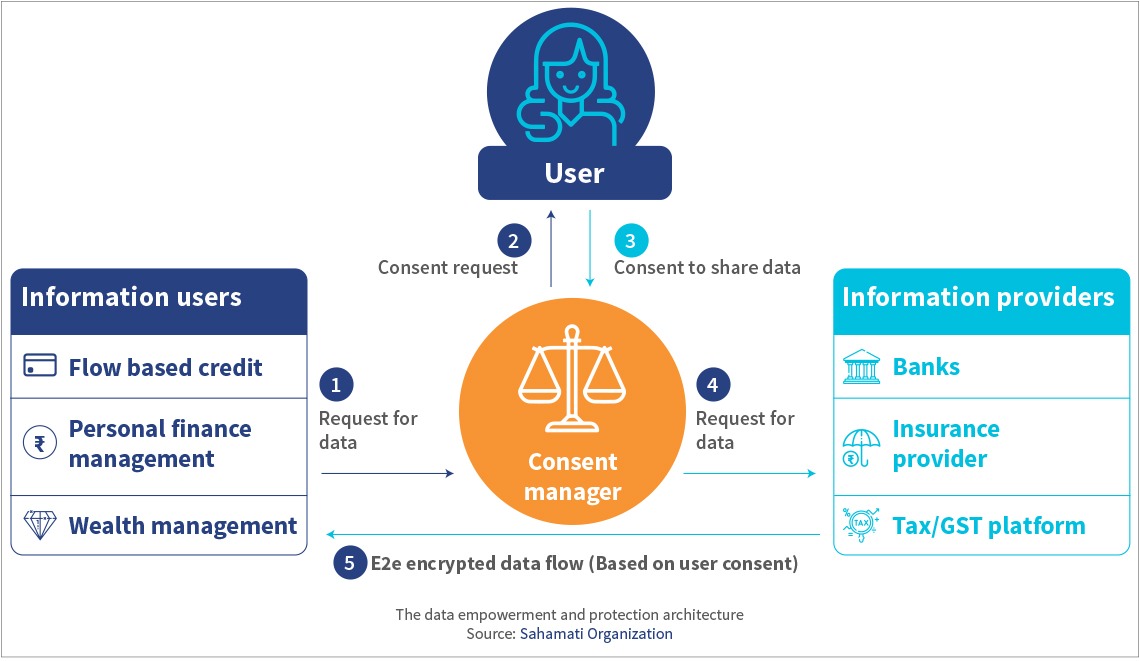
NODE will enable innovators to build financial inclusion-focused solutions across various sectors on top of open standards, open application programming interfaces (APIs), and other regulated architecture for the public good. This new consent framework will use the data for good while maintain consumer privacy. We highlight how such a framework used by different stakeholders can benefit someone like Vineet, a kirana store owner in Mumbai.
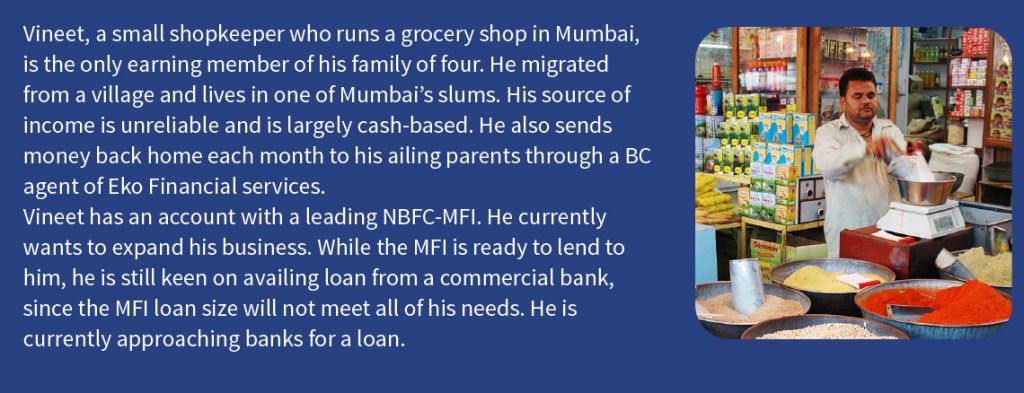
In such cases, the role of account aggregators (AA) and technical service providers (TSPs) assumes critical importance. The Reserve Bank of India established an “NBFC account aggregator.” in 2017. This regulated entity aggregates and provides information on various accounts held by a customer in different banking entities. Based on the customer’s consent, the AA will retrieve, consolidate, and organize data about the multiple types of financial engagement by a customer among various financial products, such as insurance and mutual funds.
Under NODE’s consent architecture, Vineet can use an account aggregator app to fetch his financial data from different like Eko (remittance transactions) and NBFC-MFIs (loan account). He can share these transactions fully encrypted with any financial information user (FIU) like a commercial bank. The FIUs can use this information to assess his creditworthiness and approve his loan application. A technical service provider (TSP) supports these financial institutions to become a part of the framework as FIPs or FIUs by building their foundation modules to connect with account aggregators in the ecosystem.
Finarkein analytics plays the role of TSP here, where they support the financial institutions to on-board the DEPA framework by developing these modules. On top of this, Finarkein provides its data analytics engine to ensure efficient use of data by financial institutions to cater to a broader range of customers from the low- and moderate-income (LMI) segment. As an enabler, the startup plays an invisible role by quietly developing the back-end technology infrastructure to improve processes and renew legacy systems of financial institutions in the ecosystem.
The light bulb moment

While working for an IT company in Pune, Nikhil and Dheeraj, two experienced Computer Science Engineers, shared their beliefs around data sharing and data privacy. The duo was mainly concerned with how through privacy-intrusive techniques in the current environment.
As some public digital goods like the DEPA framework were coming to life, the duo realized that the NODE itself had specific gaps and limitations regarding data consumption and management, which innovators like themselves could potentially solve. With this DEPA framework, every entity looking to consume data has to rely on account aggregators for the data and the user’s consent. The FIU can directly use this data, or a participating TSP can help generate granular insights on the user. Realizing that they could operate in this specific domain, they started Finarkein and hired a few developers to build “Flux,” a data analytics platform.
The birth of Flux—the unique pitch
The Flux platform empowers developers to iterate, deploy, and experiment rapidly to build data-driven experiences in the financial services industry. The potential clientele for Flux in India encompasses 200-odd banks, 9,500 NBFCs, and thousands of other companies that will need technology to help them adapt to the AA paradigm. As a TSP tool, Flux brings solutions for them to build the middleware to help:
- FIP and FIU share and consume data in of account aggregator framework
- FIP and FIU manage customer consent and customer data (data governance and data security products)
- Financial institutions to provide good AA UI/UX flows on their apps
Besides these opportunities around AAs themselves, Flux also has several options to build software products and offer services for cash flow lending, personal finance management, and UPI applications. Financial institutions are yet to fully adopt the India Stack’s consent layer with the DEPA framework as financial information providers and financial information users. Finarkein wants to support financial institutions that cater to LMI customers as an early TSP in the market. This last layer for the “democratization of financial services” focuses on using various data points to support incumbent and new-age startups to develop and deliver innovative solutions. Onboarding the DEPA framework is still a wait-and-but as one of the first TSPs, Finarkein seeks to target specific players with an LMI customer base to improve the accessibility of financial services for people like Vineet.
The evolution: Identifying and overcoming challenges
A significant challenge for Finarkein has remained the development of its value proposition. The space is nascent, and early adopters remain limited in . The Finarkein team has found it challenging to find the right direction for strategic expansion. Like with any other startup, limited resources have been another challenge. The FI lab supported Finarkein’s team to build its value proposition for potential clients in the lending space. MSC analyzed and provided insights on targeting these clients with specific use cases and pitches based on their needs and current data analytics capability. This technical assistance has helped Finarkein build a stronger, more robust pitch for its prospective clientele, mainly the MFIs and SFBs.
Finarkein plans to elevate Flux into an innovative playground for developers and entrepreneurs who cater to the LMI segment, not only in financial services but also in the health space. It wants to drive the adoption of the consent-based data layer, which is India Stack’s final layer. It is focused on building a developer community to transform the space with disruptive products and services and lead the growth of open digital ecosystems in India. In their work as a TSP, Finarkein wants to ensure that everyone can enjoy the benefits of this digital infrastructure—notably smaller entrepreneurs like Vineet who need it the most.
This blog post is part of a series that covers promising FinTechs that are making a difference to underserved communities. These startups receive support from the Financial Inclusion Lab accelerator program. The FI Lab is a part of CIIE.CO’s Bharat Inclusion Initiative and is co-powered by MSC. #TechForAll #BuildingForBharat
